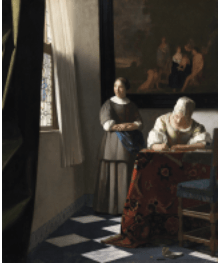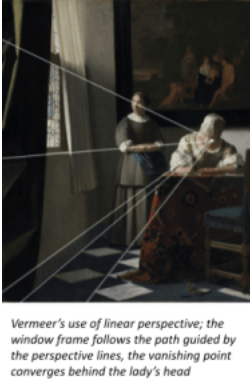Grace Ezzati
Analysis of Vermeer’s Lady Writing a Letter with her Maid

Johannes Vermeer, Lady Writing a Letter with her Maid, 1670, Oil on canvas , 72 cm x 58 cm , National Gallery of Ireland
Johannes Vermeer was a Dutch painter whose works are amongst the most notable for encapsulating the quintessence of the Dutch Golden era. His mastery of chiaroscuro, a staple of the Baroque style, and realism are distinctive of his era and recognised as his creation. Vermeer is famed for his ability to capture the nuances and minutiae of the Dutch lifestyle in the 17th century. Amongst his influences was his Dutch upbringing. It impacted his attitude towards domesticity and homogeneity, two themes that often permeate his work. The Italian Baroque style, characterised by utilising light and movement to create dramatised art pieces, was also a significant inspiration in Vermeer’s style.
Vermeer’s Lady Writing a Letter with her Maid (1670) is an expressive and introspective interpretation of Dutch culture in the 1700s. Vermeer reflects the relationship between a wealthy lady and her maid, representing their dynamic through their posture and position within the frame. The womens’ positions also represent Vemeer’s exploration of subverting the dynamic of social classism by placing a maid, a lower-class citizen, above her mistress. The maid stands in the direct centre of the piece, expressive of Vermeer twisting the symbolism behind what should be considered essential and worthy of being at the centre of attention.
Further, the success of Vermeer’s realism lies in how he relates compositional design and linear perspective to the theme of his work. Linear perspective establishes a coherent sense of depth to a realistic image and creates the sensation that the objects appear in different positions and at different distances from the viewer. All lines parallel with the viewer’s line of sight recede to the horizon towards the vanishing point opposite to the viewer.
 Among one of Vermeer’s greatest successes was his use of colour. The colour palette is desaturated yet warm. Slight hints of vermillion and ultramarine appear in the tablecloth and the maid’s apron. The muted tones elicit a sense of modesty and mundanity. The light that diffuses through the window is soft, creating gentle shadows on the two women’s faces. While the lighting is not dramatic, its effect on the atmosphere unifies the piece. In the white sleeves of the lady, Vermeer uses more generalised and looser forms and broken tones to guide the audience’s attention to more complex parts of the painting without detracting from the overall effect. The decision to use the slightest bit of abstraction was intended to enhance aspects of reality the artist does want to communicate and vice versa; remove aspects of reality that are not important.
Among one of Vermeer’s greatest successes was his use of colour. The colour palette is desaturated yet warm. Slight hints of vermillion and ultramarine appear in the tablecloth and the maid’s apron. The muted tones elicit a sense of modesty and mundanity. The light that diffuses through the window is soft, creating gentle shadows on the two women’s faces. While the lighting is not dramatic, its effect on the atmosphere unifies the piece. In the white sleeves of the lady, Vermeer uses more generalised and looser forms and broken tones to guide the audience’s attention to more complex parts of the painting without detracting from the overall effect. The decision to use the slightest bit of abstraction was intended to enhance aspects of reality the artist does want to communicate and vice versa; remove aspects of reality that are not important.
Although art produced in Delft at the time was meant to revolve around religious themes, Lady Writing was art made for art’s sake. The size of the piece is also relatively small because paintings around this time were often hung inside the home and needed to be of a lesser scale. A supposed purpose of this piece is as a private decorative ornament, for it was completed ten years before Vermeer’s premature death in 1675.
Bibliography
Artble. “Johannes Vermeer.” Artble, Artble, 2021,
https://www.artble.com/artists/johannes_vermeer. Accessed 29 July 2021. Janson, Jonathan. “Lady Writing a Letter with her Maid.” The Complete Interactive Vermeer Catalogue, essential vermeer, 2021,
http://www.essentialvermeer.com/catalogue/lady_writing_a_letter.html. Accessed 29 July 2021.